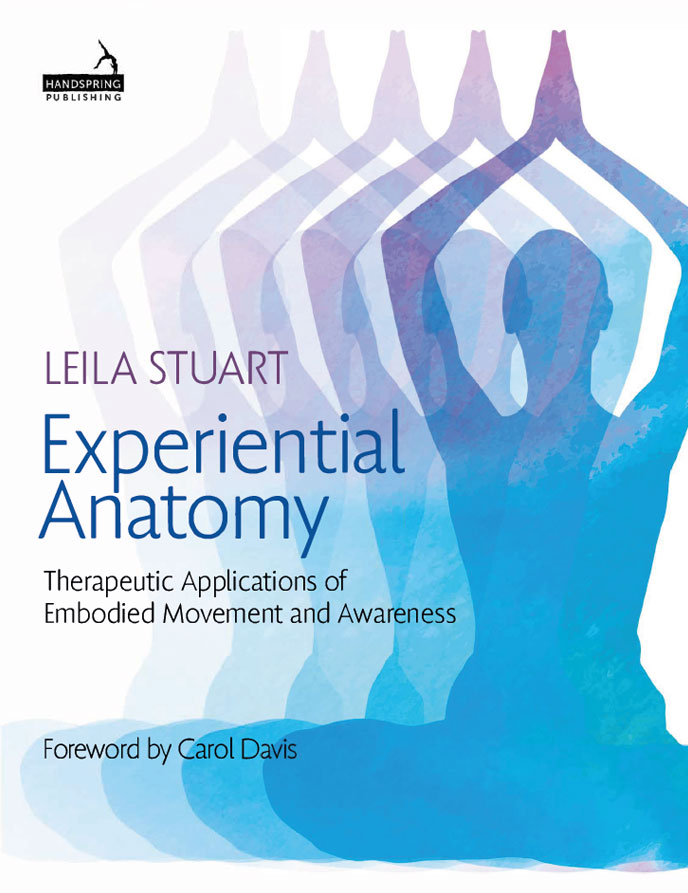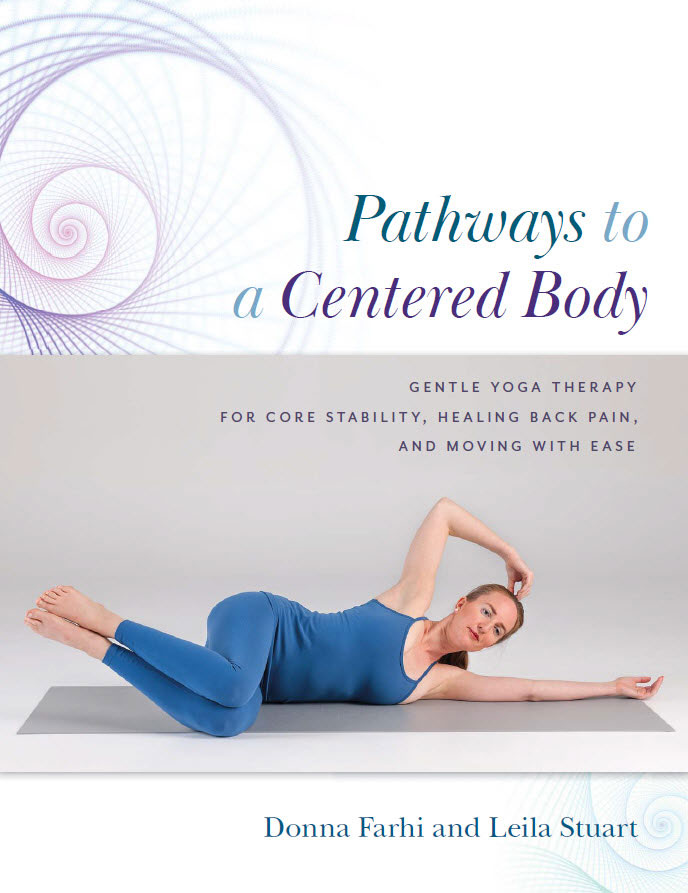Books
Experiential Anatomy:
Therapeutic Applications of Embodied Movement and Awareness

In this illustrated guide to therapeutic applications of experiential anatomy, yoga therapy is used as a framework for somatic exploration. After introducing key foundational and learning principles, subsequent chapters simplify complex anatomical information into digestible components that are integrated into accessible therapeutic practices. Each experiential chapter contains a wealth of explorations incorporating breath, self-palpation, somatic inquiry, and yoga postures that collectively nurture a felt sense of anatomical parts, their interrelationships, and their connection to the multidimensional Whole. These simple embodied practices motivate self-regulation and awaken inner wisdom.
Limited Time Offer!
Save 20% by using discount code LEILA20
Subscribe to receive a free chapter of my latest book Experiential Anatomy: Therapeutic Applications of Embodied Movement and Awareness
Leila Stuart’s brilliant book is a milestone in combining subjective experience with the frameworks and languages of many distinct disciplines: physiology, psychology, neuroscience, complementary medicine, yoga theory and practice, fascia release therapy, and pain rehabilitation. It will be of immense value to both health practitioners and those with chronic illness.
Leila, I want to thank you from the bottom of my teaching heart for creating Experiential Anatomy. It’s more than a textbook—it’s the resource I’ve been waiting for over the past 20 years of teaching somatic anatomy. The way you integrate fascia, interoception, biotensegrity, and somatic inquiry is not only anatomically grounded but profoundly therapeutic.
As a Yoga Therapist and educator in one of the only Master of Science programs in Yoga Therapy, I chose your book as a required text because it bridges the gap between functional movement, emotional embodiment, and clinical application. It empowers students to understand the body not as a machine, but as a living expression of experience.
I’ve always believed that when patients and students understand their anatomy and functional movement, healing can truly begin. Your book offers that understanding—and goes further by inviting readers into an experiential relationship with their bodies. I’m so grateful for your clarity, patience, and insight in bringing this work into the world. It’s already changing how I teach, and how my students relate to themselves.”
Drawing from her extensive experience and research, Leila Stuart expertly teaches the reader how to befriend the body, and heal what needs to heal. I love the way she encapsulates the process into three steps: Learn it, Feel it, and Heal it, a paradigm that she develops for each part of the body. The book is structured around the yogic teaching that we are holistic beings, with layers of consciousness that define our daily experience. Healing has to involve our physical, energetic, mental, emotional and spiritual selves, and these considerations are expertly woven into this book. Essential reading for anyone in the health care professions, and anyone who undertakes a journey of self-discovery, healing and empowerment.
This book is a lovely companion to the concepts of experiential anatomy (EA), yoga, somatic work, and more. The author invites the reader (and embodied mover) to cultivate self-awareness throughout this work. Richly illustrated with anatomy drawings and photos of the demonstrated movement experientials, there is plenty of material to play with and Leila Stuart does a wonderful job of inviting the reader to see and feel the holistic nature of the body and how it connects globally.
“(This book) is in a league of its own in terms of extensiveness, expertise, and excellence in educating clients, patients and teachers inner awareness through experiential anatomy. It will appeal to all who are interested in translating intellectual information into an inner experience that can be understood and embodied in ways that facilitate healing and integration from within. Read and followed with mindful focus, this book can transform teachers’ and students’ practice from where it is, to where it needs to be to facilitate systematic balance and healing.”
Pathways to a Centered Body:
Gentle Yoga Therapy for Core Stability, Healing Back Pain and Moving with Ease

Leila joined forces with internationally renowned author and teacher, Donna Farhi, to produce a definitive guide to centering the body in a multidimensional way. The foundation of the book is a protocol developed by Leila over 25 years of working with a diverse population of students. It is a gentle, yet incredibly effective, approach to balancing body structure for optimal pain-free movement.
This book demystifies the catch phrase “core fitness” and teaches you how to center your pelvis and find optimal spinal alignment as the foundation for true core strength and stability. As deeply held tension is resolved, this work will help you to feel more grounded, mentally focused, emotionally calm, and better able to stay connected to yourself and to others.
Farhi and Stuart have a gift for making anatomy relevant and easy to understand. However, while Pathways to a Centered Body includes an abundance of fascinating anatomical information, the heart of this book is imminently practical. Their six-phase process for psoas rehabilitation is comprised of thoughtful exercises designed to improve the functionality and health of this key stabilizer. A perfect blend of practice and theory, Pathways to a Centered Body will transform your relationship to your psoas – and to yourself.
…this is embodied anatomy at its very best–a veritable treasure trove of tried and tested practices. Prepare to enter with one body and leave with another.
Simultaneously radical and down-to-earth, Pathways to a Centered Body will help readers create a sustainable Yoga practice—both on and off the mat.
…clear, intelligent, and an easily absorbed guide with beautiful illustrations and photos…
Donna Farhi and Leila Stuart’s Pathways to a Centered Body is nothing short of a foundational, comprehensive, and wonderfully accessible treatise on self-awareness; and in this marvelous instance, the self can be defined as the psoas. Having read this carefully-crafted book and having begun to integrate the exercises into my Yoga practice, I will never sit, stand, walk, twist, bend, or lie down ever again without a profound appreciation for my psoas and all it connects to—physically, emotionally, and spiritually.
“…the most thorough, educational, and delightful read on the multi-dimensional area we know best as the pelvis.”
A pragmatic, cutting-edge, intelligently applied therapy that empowers us to self-heal.
Learn more about
classes and workshops
In classes and workshops, students mindfully explore the “laboratory” of their own body. They become curious about the vast world inside and how the physical body, breath, emotions, and personal and cultural conditioning influence each other. Yoga therapy practices include experiential anatomy, somatic explorations, breath, mindfulness, neural repatterning, and yoga tools. The deeper teachings of yoga underlie ALL practices. Students will increase interoceptive awareness, cultivate resilience, self-compassion and self-regulation, and become active participants in their own healing process. The result is transformation and a deeper sense of Wholeness.








